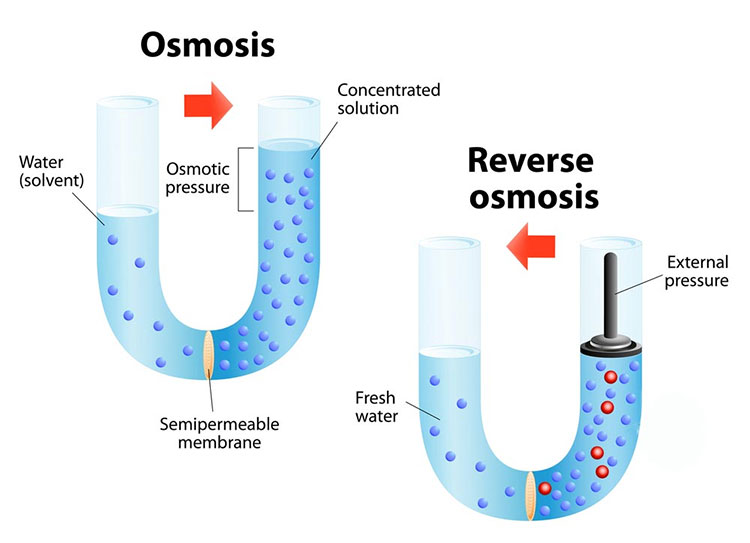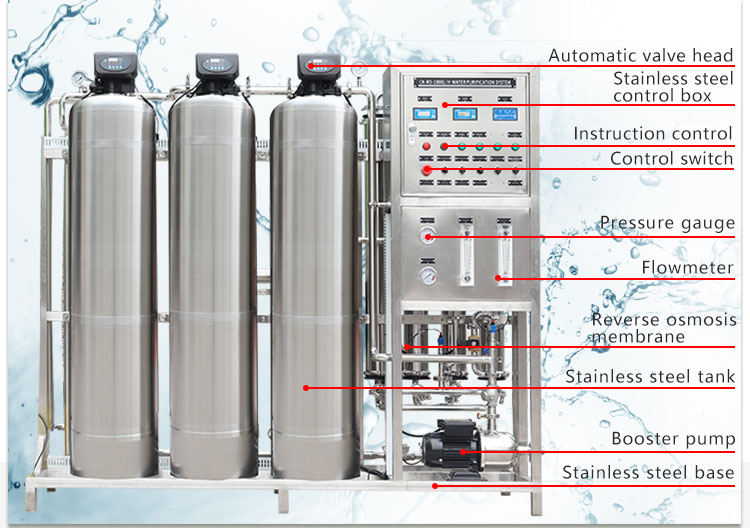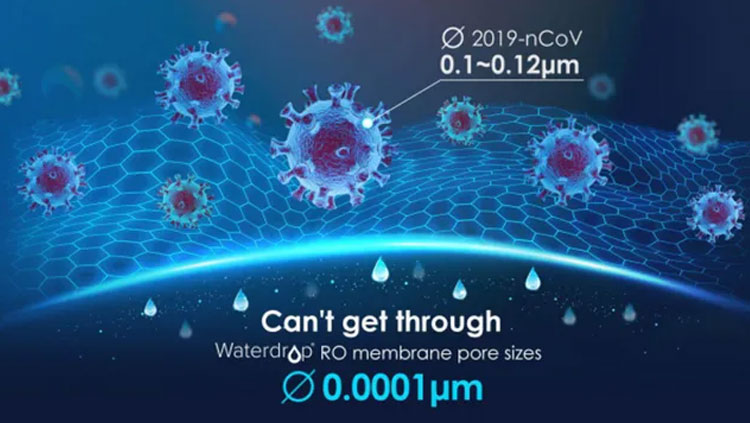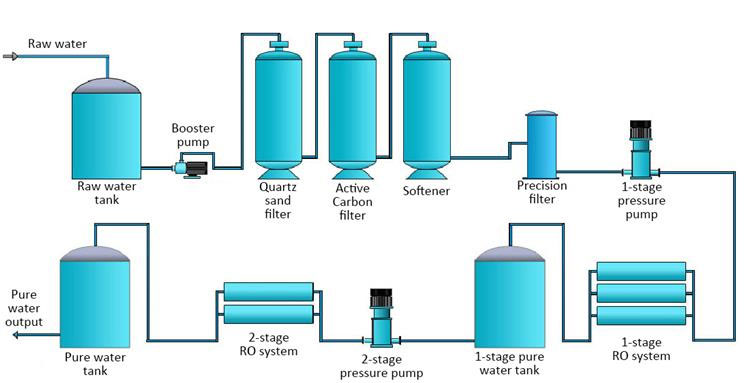- Commercial Reverse Osmosis Water Treatment Systems
- Industrial Reverse Osmosis Water Treatment Systems
- Ultrafiltration UF Water Treatment Systems
- Ion Exchange Water Treatment System
- Containerized Water Treatment Systems
- Customized Water Treatment System
- Bottle Water Filling Line
- Water Mechanical Micron Filters
- Stainless Steel Water Treatment Equipments
- Water Treatment Parts
- Water Sterilization
How Does Reverse Osmosis System Work ?
Reverse osmosis is the process by which an applied pressure, greater than the osmotic pressure, is exerted on the compartment that once contained the high-concentration solution ( Figure 1.1). This pressure forces water to pass through the membrane in the direction reverse to that of osmosis. Water now moves from the compartment with the high-concentration solution to that with the low concentration solution. In this manner, relatively pure water passes through membrane into the one compartment while dissolved solids are retained in the other compartment. Hence, the water in the one compartment is purified or “demineralized,” and the solids in the other compartment are concentrated or dewatered.

Figure 1.1 Reverse osmosis is the process by which an applied pressure, greater than the osmotic pressure, is exerted on the compartment that once contained the highconcentration solution, forcing water to move through the semipermeable membrane in the reverse direction of osmosis.

General rejection capabilities of most polyamide composite membranes at room temperature.
| Species | Rejection |
| Sodium | 92–98 |
| Calcium | 93-99+ |
| Magnesium | 93–98 |
| Potassium | 92–96 |
| Iron | 96–98 |
| Manganese | 96–98 |
| Aluminum | 96–98 |
| Ammonium* | 80–90 |
| Copper | 96–99 |
| Nickel | 96–99 |
| Zinc | 96–98 |
| Silver | 93–96 |
| Mercury | 94–97 |
| Hardness | 93–99 |
| Chloride | 92–98 |
| Bicarbonate | 96–99 |
| Sulfate | 96–99+ |
| Fluoride | 92–95 |
| Silicate | 92–95 |
| Phosphate | 96–98 |
| Bromide | 90–95 |
| Borate | 30–50 |
| Chromate | 85–95 |
| Cyanide | 90–99+ |
| Cyanide | 90–99+ |

So as you see from the table, reverse osmosis membranes can remove most of matter. RO Membrane pores size 0.0001µm, it is smaller than most of minerals, bacteria and viruses. To understand membrane filtration in reverse osmosis system, please watch our below video.

Now, we show a typical Reverse Osmosis System flow diagram. As you see from flow diagram; Water send from water storage tank to multimedia filter, it is sand filter tank, remove bigger particles, if water has odor, taste and excess of chloride, we are using activated carbon filter tank, if your water has hardness problem, we are using ion exchange resin as softener filter tank and if necessary, before or after pretreatment we add chemical dossing system (for pH, antiscalant, antifouling, chlorination, dechlorination…etc). Pretreatment tanks sand and carbon filter has backwash futures, manual or automatically, you can wash your media and use effectively.
After filter tanks, water goes to cartridge filter housing or bag filter housing, we are using generally. 1µm or 5µm PP cartridge filter or bag, this filter is called as security filter also, because it is responsible not to pass any bigger particle to membrane surface. After cartridge filter housing, salt water purification process continues with high pressure pump, it makes high pressure for membrane filtration at reverse osmosis system.
We see all this parts in real system and explain by video.
Our reverse osmosis systems are categorized in two section: Commercial Reverse Osmosis System and Industrial Reverse Osmosis System. If water output capacity is less than 2000liter per hour, we call this kind of system as commercial reverse osmosis system, if bigger than 2000lph, it is industrial reverse osmosis system.
Toget more info about our commercial and industrial reverse osmosis system, please click the links:
1. Commercial reverse osmosis system
2. Commercial brackish water reverse osmosis system
3. Commercial seawater reverse osmosis system
4. Industrial reverse osmosis system
5. Industrial brackish reverse osmosis system
6. Industrial sea water reverse osmosis system




